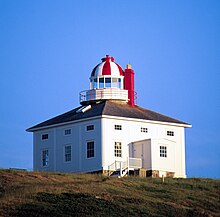Cape Spear

The 1836 lighthouse
|
|
| Location | Cape Spear St. John's, Newfoundland and Labrador Canada |
|---|---|
| Coordinates | 47°31′12.1″N 52°37′25.0″W / 47.520028°N 52.623611°W |
| Year first constructed | 1836 (first) |
| Year first lit | 1955 (current) |
| Construction | limestone tower (first) concrete tower (current) |
| Tower shape | octagonal prism tower with balcony and lantern rising from the square roof of the keeper’s house (first) octagonal prism tower with balcony and lantern (current) |
| Markings / pattern | white tower and lantern, dome with red and white stripes (first) white tower and lantern, red balcony rail (current) |
| Height | 11 metres (36 ft) (first) 13.7 metres (45 ft) (current) |
| Focal height | 71 metres (233 ft) |
| Characteristic | Fl (3) W 15s. |
| Admiralty number | H0454 |
| CHS number | CCG 507 |
| NGA number | 1868 |
| ARLHS number | CAN-748 (first) CAN-148 (current) |
| Managing agent | Parks Canada |
Cape Spear, located on the Avalon Peninsula near St. John's, Newfoundland, is the easternmost point in Canada (52°37'W), and North America, excluding Danish-controlled Greenland.
Cape Spear is within the municipal boundaries of the city of St. John's, located about 2 miles (3.2 km) from Blackhead, an amalgamated area of St. John's.
The Portuguese named this location "Cabo da Esperança" which means "cape of hope", which became "Cap d'Espoir" in French and finally "Cape Spear".
Cape Spear is the trailhead/trail end for two components of the East Coast Trail.
A lighthouse has operated at Cape Spear since September 1836. The original Cape Spear lighthouse was the second lighthouse built in Newfoundland; the first was built in 1810 at Fort Amherst, at the entrance to St. John's Harbour. In 1832, the first legislative assembly for the colony created a lighthouse board. Cape Spear was chosen as the site for a new lighthouse because it was on the rocky eastern coast near the entrance to St John's harbor.
Nicholas Croke and William Parker, two St. John's builders, won the contract for the lighthouse and work began in 1834 or early in 1835. The first lighthouse was a square wooden building with a tower in the middle containing the light. A foghorn was added in 1878. The first light used at Cape Spear had already been used since 1815 at a lighthouse at Inchkeith on the east coast of Scotland. This light used seven Argand burners and curved reflectors. This was later replaced by a dioptric lens system; the light was first lit by oil, then acetylene, and finally electricity in 1930.
Because of its proximity to convoy routes during the Second World War, a gun battery including two Lend-Lease ex-US 10-inch M1888 guns on disappearing carriages was installed at Cape Spear to defend the entrance to St. John's harbor. Barracks and underground passages leading to the bunkers were built for the use of troops stationed there. The gun barrels remain in place.
...
Wikipedia
